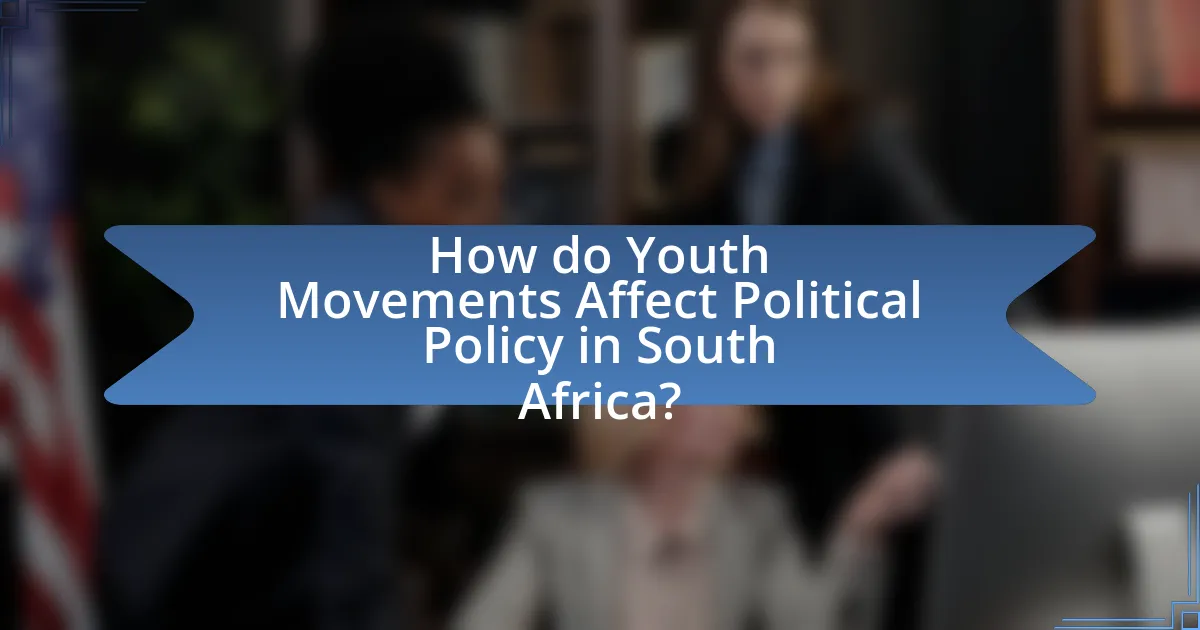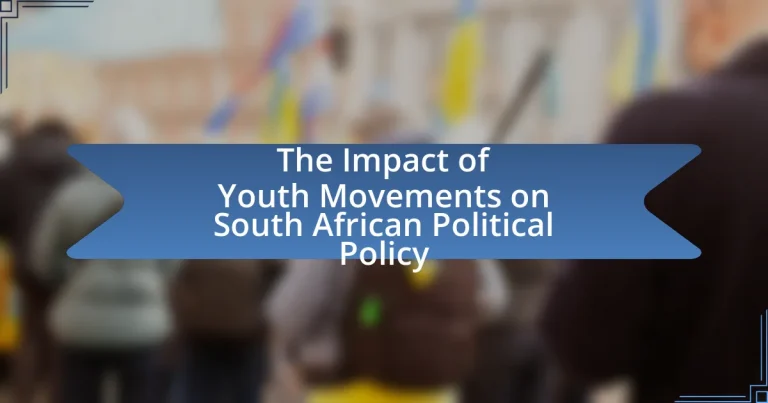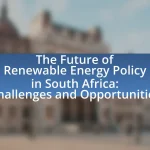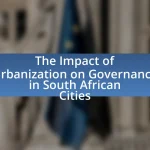Youth movements in South Africa are organized groups of young individuals advocating for social, political, and economic change, significantly influencing political policy. Historically, these movements have mobilized youth to challenge oppressive regimes, as seen in events like the 1976 Soweto Uprising and contemporary initiatives such as the #FeesMustFall campaign. The article explores the objectives of youth movements, their impact on legislative changes, and the challenges they face, including political repression and socioeconomic barriers. It also highlights the strategies youth movements can adopt to enhance their effectiveness, such as coalition-building and leveraging social media for advocacy.

What are Youth Movements and Their Role in South Africa?
Youth movements in South Africa are organized groups of young people advocating for social, political, and economic change. These movements play a crucial role in shaping political policy by mobilizing youth to engage in activism, raise awareness on issues such as education, unemployment, and inequality, and influence government decisions. For instance, the #FeesMustFall movement, which began in 2015, successfully pressured the government to freeze tuition fees at public universities, demonstrating the significant impact youth activism can have on national policy.
How have youth movements historically influenced South African politics?
Youth movements have historically influenced South African politics by mobilizing young people to challenge oppressive regimes and advocate for social justice. For instance, the 1976 Soweto Uprising, led by students protesting against the imposition of Afrikaans in schools, galvanized national and international attention towards the anti-apartheid struggle, ultimately contributing to the dismantling of apartheid. Additionally, organizations like the African National Congress Youth League have played pivotal roles in shaping policies and leadership within the broader anti-apartheid movement, emphasizing the importance of youth voices in political discourse. These movements have consistently demonstrated the capacity of youth to effect change and influence political agendas in South Africa.
What key events marked the rise of youth movements in South Africa?
Key events that marked the rise of youth movements in South Africa include the 1976 Soweto Uprising, the formation of the South African Students’ Organization in the 1960s, and the establishment of the Congress of South African Students in 1979. The Soweto Uprising, where students protested against the imposition of Afrikaans as the medium of instruction, resulted in widespread violence and drew international attention to the apartheid regime. The South African Students’ Organization, founded by Steve Biko, emphasized black consciousness and mobilized youth against racial oppression. The Congress of South African Students further organized student activism, advocating for educational reform and political rights. These events collectively galvanized youth participation in the anti-apartheid struggle, significantly influencing South African political policy.
How did apartheid shape the objectives of youth movements?
Apartheid significantly shaped the objectives of youth movements by galvanizing them to fight against systemic racial oppression and demand equal rights. The oppressive policies of apartheid, which enforced racial segregation and discrimination, motivated young South Africans to organize and mobilize for social justice, leading to the formation of groups like the South African Students’ Organization (SASO) and the Black Consciousness Movement. These movements aimed to empower black youth, promote political awareness, and challenge the apartheid regime, culminating in pivotal events such as the Soweto Uprising in 1976, where thousands of students protested against the imposition of Afrikaans in schools. This uprising highlighted the youth’s role in the anti-apartheid struggle and underscored their objectives of achieving political freedom and social equality.
What are the main objectives of contemporary youth movements in South Africa?
The main objectives of contemporary youth movements in South Africa include advocating for social justice, promoting political engagement, and addressing economic inequality. These movements aim to empower young people to participate actively in the democratic process, as evidenced by initiatives like the #FeesMustFall campaign, which successfully challenged rising university fees and highlighted the need for accessible education. Additionally, youth movements focus on issues such as unemployment and land reform, reflecting the broader socio-economic challenges faced by the youth in South Africa.
How do these objectives align with national political goals?
The objectives of youth movements in South Africa align with national political goals by advocating for social justice, economic equality, and democratic participation. These movements often focus on issues such as education reform, job creation, and anti-corruption, which resonate with the government’s commitments outlined in the National Development Plan. For instance, the South African government aims to reduce unemployment and improve educational outcomes, goals that youth movements actively support through protests and policy proposals. This alignment is evident in the government’s response to youth-led initiatives, which often leads to policy changes that reflect the demands of these movements, thereby reinforcing their influence on national political discourse.
What issues do youth movements prioritize today?
Youth movements today prioritize issues such as climate change, social justice, education reform, and mental health. These movements advocate for urgent action on climate policies, emphasizing the need for sustainable practices to combat environmental degradation. Social justice initiatives focus on combating systemic inequalities, including racial and gender discrimination, while education reform seeks to improve access and quality of education for all. Additionally, mental health awareness has gained prominence, with youth advocating for better resources and support systems. These priorities reflect a collective demand for transformative change in society, driven by the urgency of these interconnected issues.

How do Youth Movements Affect Political Policy in South Africa?
Youth movements significantly influence political policy in South Africa by mobilizing young citizens to advocate for change, thereby shaping legislative agendas. For instance, the #FeesMustFall movement, which emerged in 2015, successfully pressured the government to reconsider tuition fees and led to policy changes regarding higher education funding. This movement highlighted the power of collective youth action, resulting in increased government accountability and responsiveness to youth concerns. Additionally, youth organizations often engage in political discourse, pushing for policies that address issues such as unemployment, education, and social justice, thereby directly impacting the political landscape in South Africa.
What mechanisms do youth movements use to influence political policy?
Youth movements influence political policy through mechanisms such as grassroots organizing, social media campaigns, and strategic alliances with established political entities. Grassroots organizing allows youth to mobilize communities, exemplified by the #FeesMustFall movement in South Africa, which successfully pressured the government to reconsider tuition fees. Social media campaigns amplify their messages and reach wider audiences, as seen in the use of platforms like Twitter and Instagram to raise awareness and rally support. Additionally, forming strategic alliances with NGOs and political parties enhances their influence, enabling youth movements to leverage resources and gain access to political discussions, thereby shaping policy outcomes effectively.
How do protests and activism shape legislative changes?
Protests and activism significantly influence legislative changes by mobilizing public opinion and pressuring lawmakers to address specific issues. For instance, the #FeesMustFall movement in South Africa, which began in 2015, highlighted the financial burdens of higher education, leading to government commitments to freeze tuition fees and increase funding for universities. This activism demonstrated the power of collective action, as it garnered widespread media attention and support from various sectors, compelling legislators to respond to the demands of the youth. Historical evidence shows that sustained protests can lead to tangible policy shifts, as seen in the Civil Rights Movement in the United States, which resulted in landmark legislation like the Civil Rights Act of 1964.
What role does social media play in mobilizing youth for political change?
Social media serves as a crucial tool for mobilizing youth for political change by facilitating communication, organization, and awareness. It enables young people to share information rapidly, coordinate protests, and engage in discussions about political issues. For instance, during the #FeesMustFall movement in South Africa, social media platforms like Twitter and Facebook were instrumental in organizing mass protests against rising university fees, demonstrating the power of digital communication in rallying youth around a common cause. Research indicates that 70% of young South Africans use social media, highlighting its significance in shaping political discourse and activism among this demographic.
What successes have youth movements achieved in influencing policy?
Youth movements in South Africa have successfully influenced policy by advocating for educational reform, environmental justice, and social equality. For instance, the #FeesMustFall movement led to significant changes in higher education funding policies, resulting in the South African government announcing a freeze on tuition fees in 2016. Additionally, youth-led initiatives have pushed for the inclusion of climate change policies in national agendas, exemplified by the involvement of young activists in the 2019 Climate Strike, which garnered widespread media attention and prompted discussions in Parliament. These movements have mobilized thousands, demonstrating their capacity to shape public discourse and policy outcomes effectively.
Which specific policies have been directly impacted by youth activism?
Youth activism in South Africa has directly impacted several specific policies, including the National Development Plan (NDP) and the Free Education Policy. The NDP, which aims to eliminate poverty and reduce inequality, was influenced by youth movements advocating for social justice and economic opportunities. Additionally, the Free Education Policy, established in 2018, was a direct response to the #FeesMustFall movement, which highlighted the need for accessible education for all students. These policies reflect the significant role that youth activism has played in shaping South Africa’s political landscape.
How do these successes compare to challenges faced by youth movements?
Youth movements in South Africa have achieved significant successes, such as influencing policy changes and increasing political engagement among young people, yet they face substantial challenges, including governmental resistance and socio-economic barriers. For instance, the Fees Must Fall movement successfully pressured the government to implement fee-free education for poor students, demonstrating the power of collective action. However, these movements often encounter challenges like police brutality, lack of funding, and internal divisions, which can undermine their effectiveness. The juxtaposition of these successes and challenges highlights the resilience of youth movements in navigating a complex political landscape while striving for meaningful change.

What Challenges Do Youth Movements Face in South Africa?
Youth movements in South Africa face significant challenges, including political repression, lack of funding, and internal divisions. Political repression manifests through government crackdowns on protests and activism, which stifles youth voices and limits their ability to mobilize effectively. Additionally, many youth movements struggle with inadequate financial resources, hindering their capacity to organize events, campaigns, and outreach efforts. Internal divisions, often stemming from differing ideologies and priorities among members, can lead to fragmentation and weaken collective action. These challenges impede the overall impact of youth movements on South African political policy, as they struggle to present a united front and influence decision-making processes.
How do political and social barriers hinder youth movements?
Political and social barriers significantly hinder youth movements by restricting their ability to organize, express dissent, and influence policy. For instance, oppressive government regulations can limit freedom of assembly, making it difficult for youth to gather and advocate for change. Additionally, social stigmas and discrimination can marginalize youth voices, particularly those from disadvantaged backgrounds, reducing their participation in movements. Historical examples, such as the apartheid era in South Africa, illustrate how political repression stifled youth activism, leading to a lack of representation in political discourse. Furthermore, studies show that youth movements often face challenges in accessing resources and platforms, which are crucial for mobilization and advocacy, thereby weakening their impact on political policy.
What are the main obstacles to youth participation in politics?
The main obstacles to youth participation in politics include lack of access to political education, socioeconomic barriers, and disillusionment with political processes. Research indicates that many young people feel uninformed about political issues and processes, which limits their engagement. Additionally, socioeconomic factors such as poverty and unemployment hinder their ability to participate actively in political activities. A study by the Institute for Justice and Reconciliation found that disillusionment with political parties and a perception that politics does not address their needs further alienates youth from political involvement in South Africa.
How does government response affect youth activism?
Government response significantly influences youth activism by either empowering or suppressing young activists’ efforts. When governments engage positively, such as by addressing youth concerns and facilitating dialogue, it can lead to increased participation and mobilization among young people. For instance, the South African government’s acknowledgment of youth-led movements during the Fees Must Fall protests in 2015 resulted in policy discussions regarding higher education funding, demonstrating how constructive engagement can validate and amplify youth activism. Conversely, when governments respond with repression, such as through arrests or censorship, it can deter participation and create a climate of fear, ultimately stifling activism. Historical examples include the violent crackdown on protests in Zimbabwe, which led to a decline in youth engagement in political processes. Thus, the nature of government response plays a crucial role in shaping the trajectory and effectiveness of youth activism.
What strategies can youth movements adopt to overcome these challenges?
Youth movements can adopt strategies such as coalition-building, leveraging social media, and engaging in grassroots mobilization to overcome challenges. Coalition-building allows youth movements to unite with other organizations, increasing their influence and resources, as seen in the #FeesMustFall movement, which collaborated with various student organizations to advocate for educational reforms. Leveraging social media enables youth movements to reach a wider audience quickly, facilitating awareness and support for their causes; for instance, the use of Twitter and Facebook during protests has proven effective in mobilizing participants and disseminating information rapidly. Grassroots mobilization empowers local communities to participate actively in political processes, fostering a sense of ownership and accountability, which was evident in the youth-led initiatives during the 2019 South African elections that encouraged voter registration and participation.
How can collaboration with other organizations enhance their impact?
Collaboration with other organizations can enhance impact by pooling resources, expertise, and networks to address complex social issues more effectively. For instance, youth movements in South Africa have successfully partnered with NGOs and community groups to amplify their voices and reach broader audiences, resulting in significant policy changes. A notable example is the collaboration between the #FeesMustFall movement and various civil society organizations, which led to increased government accountability regarding education funding. This partnership not only strengthened advocacy efforts but also mobilized a larger base of support, demonstrating that collective action can lead to more substantial political influence and policy reform.
What role does education play in empowering youth movements?
Education plays a crucial role in empowering youth movements by equipping young individuals with the knowledge and skills necessary to advocate for change. Through education, youth gain awareness of their rights, social issues, and the political landscape, which enables them to engage effectively in activism. For instance, studies have shown that educated youth are more likely to participate in civic activities and mobilize for social justice, as seen in the #FeesMustFall movement in South Africa, where students protested against rising tuition fees, demonstrating the power of informed youth in influencing policy. This connection between education and activism highlights how informed youth can drive significant political change.
What are the best practices for youth movements to effectively influence political policy?
Youth movements can effectively influence political policy by employing strategic advocacy, grassroots mobilization, and coalition-building. Strategic advocacy involves clearly defining policy goals and utilizing data-driven arguments to persuade policymakers. For instance, the #FeesMustFall movement in South Africa successfully highlighted the financial burdens of education, leading to policy discussions on tuition fees. Grassroots mobilization engages young people in campaigns, rallies, and social media outreach, amplifying their voices and demonstrating public support for specific issues. The use of social media platforms has been pivotal in organizing protests and spreading awareness, as seen in the global climate strikes initiated by youth activists. Coalition-building with established organizations enhances credibility and resources, allowing youth movements to leverage broader networks for greater impact. Collaborations with NGOs and community groups can provide additional support and expertise, further strengthening their advocacy efforts.
How can youth movements build coalitions for greater impact?
Youth movements can build coalitions for greater impact by fostering collaboration among diverse groups that share common goals. By identifying overlapping interests, youth movements can unite various organizations, such as environmental, social justice, and educational groups, to amplify their collective voice. For instance, the #FeesMustFall movement in South Africa successfully allied with labor unions and student organizations, leading to significant policy changes regarding tuition fees. This coalition-building approach not only enhances resource sharing but also increases visibility and influence in political discourse, as evidenced by the increased engagement of youth in national policy discussions following such collaborations.
What communication strategies are most effective for engaging policymakers?
Effective communication strategies for engaging policymakers include clear messaging, data-driven arguments, and building relationships. Clear messaging ensures that the core issues are easily understood, while data-driven arguments provide evidence that supports the proposed policies. For instance, youth movements in South Africa have successfully utilized social media platforms to disseminate information and mobilize support, demonstrating the power of digital communication in reaching policymakers. Additionally, establishing relationships through networking and direct engagement allows youth advocates to influence decision-making processes. Research indicates that personal connections and consistent follow-ups significantly enhance the likelihood of policymakers responding to advocacy efforts.


